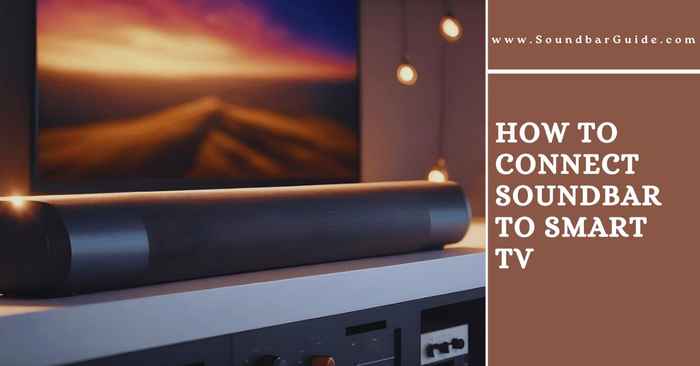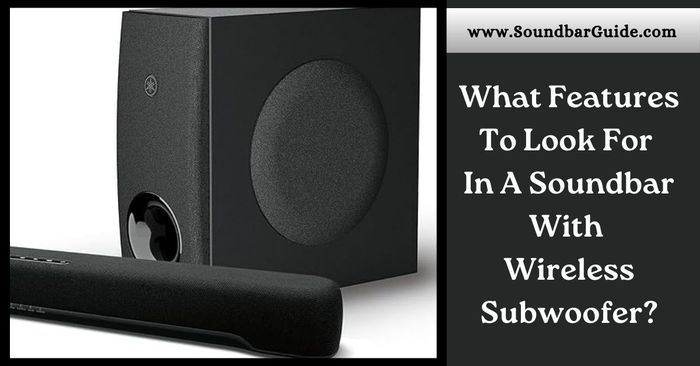A soundbar enhances your TV’s audio quality, providing a more immersive viewing experience.
Connecting a soundbar to your smart TV is straightforward and significantly improves sound clarity and volume.
So, the question is – “how to connect soundbar to smart tv?”
To connect a soundbar to a smart TV, use an HDMI ARC or optical cable. Ensure both devices are powered on and properly connected.
HDMI ARC is often preferred for its ability to carry audio both ways, reducing the number of cables needed. Optical cables are another reliable option, delivering high-quality audio without interference.
In this guide, we’ll walk you through the steps to connect your soundbar to a smart TV, exploring different methods depending on your available ports and preferred setup.
By the end, you’ll have everything you need to seamlessly integrate your soundbar with your smart TV, ensuring you get the best audio experience possible.
Soundbar And Smart TV Connection Basics
Smart TVs are now common in many households. They offer streaming, gaming, and other features. But their built-in speakers often lack quality sound. This is where soundbars come in.
A soundbar is a long, slim speaker system. It provides better sound quality for your Smart TV. Connecting a soundbar to a Smart TV can greatly improve your viewing experience.
The Rise Of Soundbars
In recent years, soundbars have gained popularity. Traditional home theater systems are bulky and complex. Soundbars are simple and sleek. They fit easily into any room. Their popularity has soared due to their ease of use. You can connect them to your TV with minimal effort.
Soundbars also come in various price ranges. This makes them accessible to many users. From budget-friendly options to high-end models, there is a soundbar for every need. This flexibility has contributed to their rise in the market.
Benefits Of Integrating Soundbar With Smart Tv
Connecting a soundbar to your Smart TV has many benefits:
- Improved Sound Quality: Enjoy clear and rich audio.
- Easy Setup: Simple to connect and use.
- Space-Saving: Slim design fits any space.
- Enhanced Experience: Better sound enhances movies and games.
Some soundbars offer wireless connectivity. This means fewer cables and a cleaner setup. Many soundbars also support Bluetooth. You can stream music from your phone or tablet. This adds more functionality to your soundbar and Smart TV setup.
Below is a simple comparison table that outlines the benefits:
| Feature | Built-in TV Speakers | Soundbar |
|---|---|---|
| Sound Quality | Poor | Excellent |
| Setup | Automatic | Simple |
| Space Requirement | None | Minimal |
| Additional Features | Limited | Many |
As you can see, soundbars offer many advantages. They are a great addition to any Smart TV. Whether you are watching movies or playing games, a soundbar enhances the experience.
Types Of Soundbars
Choosing the right soundbar can enhance your TV experience. Soundbars come in various types, each designed to meet different needs and preferences. Understanding the types can help you make an informed decision.
Basic Soundbars Vs. Surround Sound Systems
Basic soundbars are compact and easy to set up. They provide a significant audio upgrade over TV speakers. Basic soundbars are ideal for small to medium-sized rooms. They typically feature a slim design and can be mounted on a wall or placed on a TV stand.
Surround sound systems offer a more immersive audio experience. These systems often include multiple speakers and a subwoofer. They are perfect for larger rooms or home theater setups. Surround sound systems can deliver cinema-like sound quality, making movies and games more enjoyable.
| Type | Key Features |
|---|---|
| Basic Soundbars | Compact, easy setup, suitable for small rooms |
| Surround Sound Systems | Immersive audio, multiple speakers, ideal for large rooms |
Features To Look For In A Soundbar
When choosing a soundbar, consider these key features:
- Audio Quality: Look for soundbars with high-quality audio output. Check for clear dialogue and deep bass.
- Connectivity Options: Ensure the soundbar has HDMI, Bluetooth, and optical inputs. These options make connecting to your TV easier.
- Subwoofer: A built-in or separate subwoofer enhances bass performance. It provides a richer sound experience.
- Channels: More channels mean better sound distribution. 2.1, 5.1, and 7.1 are common configurations.
- Smart Features: Some soundbars come with voice control and streaming services. These features add convenience.
Compatibility Checks
Before connecting your soundbar to your smart TV, you need to perform some compatibility checks. Ensuring your devices are compatible will save you time and effort. This guide will help you identify the necessary ports and connections.
Identifying Your Smart Tv’s Audio Outputs
First, you need to locate your TV’s audio output ports. These ports are usually at the back or side of the TV. Common audio outputs include:
- HDMI ARC (Audio Return Channel)
- Optical audio (TOSLINK)
- 3.5mm headphone jack
- RCA ports (red and white)
Check your TV’s manual if you are unsure. Identifying these ports is crucial for the next step.
Matching Soundbar Inputs
Next, you need to match your TV’s audio outputs with your soundbar’s input ports. Your soundbar will likely have:
- HDMI ARC input
- Optical audio input
- 3.5mm AUX input
- RCA inputs (red and white)
Use a table to compare your TV’s outputs and soundbar’s inputs:
| TV Audio Output | Soundbar Input | Compatible |
|---|---|---|
| HDMI ARC | HDMI ARC | Yes |
| Optical audio | Optical audio | Yes |
| 3.5mm headphone jack | 3.5mm AUX | Yes |
| RCA ports | RCA inputs | Yes |
You Can Also Check Out
How To Connect Soundbar To Smart TV: Wired Connection
Wired connections offer stable and reliable sound quality. They are often preferred for connecting soundbars to smart TVs. Below are some common wired connection methods.
Connect Soundbar To Smart TV Using HDMI ARC
HDMI ARC is a simple way to connect a soundbar to a smart TV. ARC stands for Audio Return Channel. It allows both audio and video signals to travel through a single HDMI cable.
Follow these steps to use HDMI ARC:
- Check if your TV and soundbar have HDMI ARC ports.
- Plug one end of the HDMI cable into the TV’s HDMI ARC port.
- Plug the other end into the soundbar’s HDMI ARC port.
- Turn on both devices and select the HDMI ARC input on the TV.
Using HDMI ARC simplifies connections and reduces cable clutter.
Connect Soundbar To Smart TV Using Optical And Coaxial Cables
Optical and coaxial cables are other wired options. They deliver high-quality audio without interference.
To use an optical cable:
- Locate the optical ports on both your TV and soundbar.
- Connect one end of the optical cable to the TV’s optical out port.
- Connect the other end to the soundbar’s optical in port.
- Switch both devices on and select the optical input on the soundbar.
For coaxial cables, follow these steps:
- Find the coaxial ports on your TV and soundbar.
- Insert one end of the coaxial cable into the TV’s coaxial out port.
- Insert the other end into the soundbar’s coaxial in port.
- Turn on both devices and choose the coaxial input on the soundbar.
Both optical and coaxial cables ensure a strong, stable connection. They are great for high-quality audio.
How To Connect Soundbar To Smart TV: Wireless Options
Connecting your soundbar to your smart TV can greatly enhance your audio experience. One of the easiest ways to do this is through wireless connectivity options. These options offer convenience, eliminating the need for extra cables.
Connect Soundbar To Smart TV Via Bluetooth Pairing
The Bluetooth pairing process is simple and quick.
Follow these steps:
- Turn on your soundbar and put it in pairing mode.
- Go to the Bluetooth settings on your smart TV.
- Select your soundbar from the list of available devices.
- Confirm the connection and adjust the volume as needed.
Make sure the devices are within a close range for a stable connection. This method is perfect for reducing cable clutter.
Connect Soundbar To Smart TV Via Wi-Fi
Another popular wireless option is using Wi-Fi and soundbar apps. Many modern soundbars come with dedicated apps. These apps allow for seamless integration with your smart TV.
Follow these steps to connect via Wi-Fi:
- Ensure both the soundbar and TV are connected to the same Wi-Fi network.
- Download and install the soundbar’s app on your smartphone.
- Open the app and follow the on-screen instructions to connect.
- Once connected, you can control the soundbar through the app.
Using Wi-Fi provides a more stable connection compared to Bluetooth. It also offers additional features like firmware updates and sound customization.
| Wireless Option | Benefits | Steps |
|---|---|---|
| Bluetooth | Easy setup, no cables | Pair devices via Bluetooth settings |
| Wi-Fi | Stable connection, app features | Connect via the soundbar app |
Both Bluetooth and Wi-Fi offer convenient ways to connect your soundbar to your smart TV. Choose the method that best fits your needs.
Setting Up Your Soundbar
Connecting a soundbar to your smart TV can greatly enhance your viewing experience. Follow these steps to set up your soundbar quickly and easily. This guide will walk you through the key steps for a seamless setup.
Unboxing And Placement Tips
Start by unboxing your soundbar and all its accessories. Ensure you have the power cord, remote, and any cables needed for connection.
- Place the soundbar in front of your TV for the best audio experience.
- Ensure the soundbar is centered and not blocking the TV screen.
- If mounting on a wall, use the included brackets for a secure fit.
Initial Soundbar Configuration
Plug in your soundbar and turn it on. Use the remote to access the soundbar’s settings menu.
Follow these steps:
- Connect the soundbar to your TV using an HDMI ARC cable.
- Switch the TV audio output to the soundbar in TV settings.
- Adjust the soundbar’s audio settings for optimal sound quality.
Some soundbars offer Bluetooth and Wi-Fi connectivity. Check the manual for specific instructions on connecting these features.
Once connected, test the soundbar by playing different types of content. Adjust the volume and sound modes to your preference.
Audio Calibration For Optimal Sound
Connecting a soundbar to your smart TV is only the first step. To enjoy the best sound quality, you need to calibrate the audio settings. Proper audio calibration ensures that you experience crisp dialogue, rich bass, and balanced sound. Let’s explore how to adjust the soundbar settings and fine-tune the audio with your smart TV.
Adjusting Soundbar Settings
Start by turning on your soundbar and smart TV. Using the soundbar remote, access the settings menu.
- Locate the audio settings option.
- Adjust the equalizer settings to your preference.
- Increase the bass for deeper sound.
- Enhance the treble for clearer dialogue.
Some soundbars come with preset modes. These modes optimize sound for movies, music, or news. Select the mode that fits your content type. Experiment with different settings to find what sounds best.
Fine-tuning Audio With Your Smart Tv
Next, navigate to your smart TV’s audio settings. Use your TV remote to access the menu.
- Find the audio output option.
- Select the connected soundbar as the primary output.
- Adjust the volume levels to balance the sound between the TV and soundbar.
Some smart TVs offer advanced audio settings. Enable features like Dolby Atmos or surround sound for a more immersive experience. You can also sync the audio to match the video. This prevents any lag between what you see and hear.
Here is a quick reference table:
| Setting | Soundbar | Smart TV |
|---|---|---|
| Bass | Increase | Adjust if needed |
| Treble | Enhance | Adjust if needed |
| Audio Output | Not Applicable | Select Soundbar |
| Audio Sync | Auto | Manual Adjustment |
Taking these steps will ensure your soundbar and smart TV deliver the best audio performance. Enjoy an elevated home theater experience with perfectly calibrated sound.
Troubleshooting Common Issues
Connecting a soundbar to a smart TV can sometimes be tricky. Users often face issues like no sound, poor sound quality, or connectivity problems. This guide will help you troubleshoot these common issues.
No Sound Or Poor Sound Quality
If there’s no sound, first check the volume. Make sure the soundbar is not muted. Also, ensure the TV volume is turned up. Verify that the soundbar is set to the correct input source. Double-check all cables to ensure they are securely connected.
If the sound quality is poor, inspect the audio settings. Use the TV’s audio settings to select the best sound mode. Ensure your soundbar settings match the TV’s output. Try different audio presets on your soundbar. This can enhance the sound experience.
Connectivity Problems And Solutions
If the soundbar won’t connect to the TV, make sure both devices are compatible. Check if the HDMI or optical cable is properly inserted. Use a different cable if necessary. Update the firmware on both devices. Software updates can fix many connectivity issues.
If using Bluetooth, ensure both devices are in pairing mode. Make sure no other devices are interfering. Move the soundbar closer to the TV. Sometimes, physical obstacles can cause connection issues. If all else fails, reset both the TV and soundbar to factory settings.
Common Troubleshooting Steps
- Check all cables and connections.
- Ensure devices are on the correct input settings.
- Update firmware on both devices.
- Reset devices to factory settings if needed.
FAQs For How To Connect A Soundbar To A Smart TV
Do All Smart TVs Support Soundbars?
Most Smart TVs support soundbars. Check your TV’s manual or specifications to ensure compatibility and available connection options.
Why Is My Soundbar Not Working With My Smart TV?
If your soundbar isn’t working with your smart TV, it could be due to an incorrect input setting, a loose connection, or an issue with the TV’s audio output settings. Make sure the soundbar is properly connected, set to the correct input, and that your TV is set to output audio through the soundbar.
How Do I Get Sound From My Soundbar To My TV?
To get sound from your soundbar to your TV, ensure the soundbar is properly connected to the TV using either an HDMI ARC, optical cable, or Bluetooth. Once connected, set the TV’s audio output to the corresponding input source (e.g., HDMI ARC, Optical, or Bluetooth) for the soundbar.
Conclusion
To conclude, connecting a soundbar to your Smart TV is a straightforward process that significantly enhances your viewing experience by delivering superior sound quality.
Whether you choose to connect via HDMI ARC, optical cable, Bluetooth, or another method, the key is to follow the steps carefully and ensure all devices are compatible.
By taking the time to set up your soundbar correctly, you’ll be able to enjoy your favorite movies, shows, and games with richer, more immersive audio.
With the right connection, your soundbar and Smart TV will work in perfect harmony, elevating your home entertainment to new heights.
Still, if you have any questions about how to connect a soundbar to a smart tv, you can comment below…


![How To Connect Vizio Soundbar To Vizio TV: [Step By Step Guide]](https://soundbarguide.com/wp-content/uploads/2024/10/how-to-connect-vizio-soundbar-to-vizio-tv.jpg)


Leave a Reply